No products in the cart.
NEWS
Discovering Unique Fruit Tree Varieties for Your Garden
The world of fruit cultivation is constantly expanding, with many intriguing and unique fruit tree varieties making their way into gardens and farms. These less common fruits offer exciting flavors, fascinating appearances, and often boast impressive nutritional profiles, bringing significant value to growers and consumers alike. If you’re looking to diversify your harvest or simply explore the wonders of botanical novelty, delving into the realm of unique fruit trees is a rewarding endeavor. As an expert in horticulture and a content creator for Biogarden.asia, I’m thrilled to share insights into some of these remarkable species that can thrive and delight in various climates.
Jaboticaba Tree
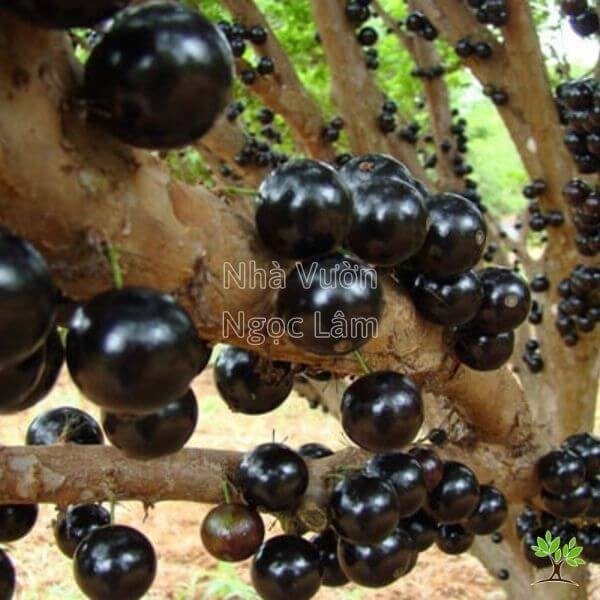 Ripe Jaboticaba fruit growing directly on the tree trunk
Ripe Jaboticaba fruit growing directly on the tree trunk
Characteristics
Known scientifically as Myrciaria cauliflora, the Jaboticaba is truly one of nature’s marvels. What sets it apart is its unique fruiting habit: the grapes, resembling small plums, grow directly from the trunk and branches of the tree, a phenomenon known as cauliflory. This evergreen tree typically reaches a height of around 6 meters but can grow taller, with trunk diameters ranging from 10 to 30 cm over time.
The leaves are lance-shaped, dark green, and measure between 3 to 10 cm long and 1.5 to 2 cm wide, though leaf size can vary by variety. Several Jaboticaba varieties exist, each with distinct traits and fruiting cycles. Some common types include:
- Common Jaboticaba: Traditionally fruits twice a year, but older, well-cared-for trees can yield more frequently.
- Four-Season Jaboticaba: True to its name, this variety can flower and fruit almost year-round once mature (typically around 5 years old), offering a continuous harvest.
- Red Jaboticaba: Distinguished by its fruit turning red upon ripening, contrasting with the typical dark purple or black of other varieties.
- Large Fruit Jaboticaba: Produces fruits two to three times larger than the common type, with ripe fruits turning black.
- Yellow Jaboticaba: Bears yellow fruits that are significantly larger (3 to 4 times) than common Jaboticaba.
- Variegated Jaboticaba: This fascinating type displays seven different colors during the fruit development process, from flowering to full ripeness, earning it the moniker “seven-colored Jaboticaba.”
Nutritional Value & Benefits
Despite being low in calories and carbohydrates, Jaboticaba fruits are packed with nutrients. A 100-gram serving typically contains around 45 calories, 1 gram of protein, 13 grams of carbohydrates, no fat, and provides essential vitamins and minerals like Vitamin C (around 12mg), Potassium, Calcium, Folic Acid, Thiamine, and Riboflavin.
The health benefits associated with Jaboticaba consumption are notable:
- Potential Anti-Cancer Properties: Some scientific studies suggest that compounds found in Jaboticaba, particularly Anthocyanins (responsible for the fruit’s dark color), may help inhibit the growth of cancer cells.
- Rich in Antioxidants: These fruits are abundant in potent antioxidants, making them excellent for promoting youthful skin and overall health, especially for older adults and women.
- Anti-Inflammatory Effects: Jaboticaba possesses strong anti-inflammatory compounds. Regular consumption may contribute to reducing the risk of chronic conditions like diabetes and cardiovascular diseases.
Finger Lime
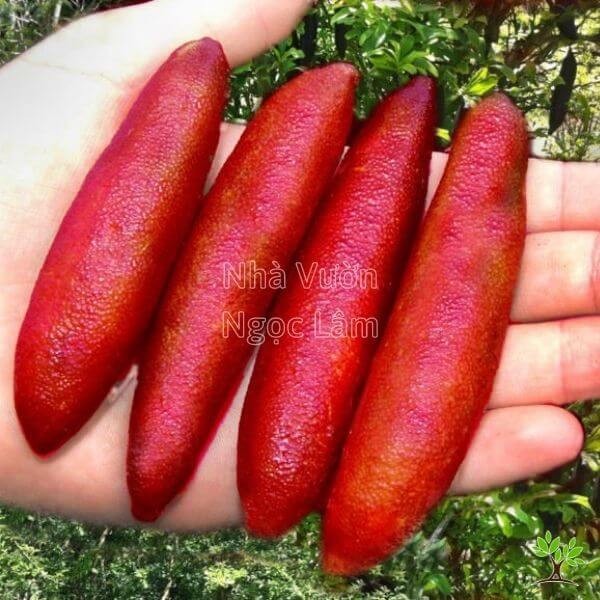 Opened Finger Lime fruit showing translucent juice vesicles resembling caviar
Opened Finger Lime fruit showing translucent juice vesicles resembling caviar
Characteristics
Finger Lime (Citrus australasica) is a unique citrus fruit with a distinctive appearance and texture. It grows on a straight, thorny tree that can reach up to 10 meters in its native environment. The fruit itself is elongated and cylindrical, typically about 10 cm long, resembling a small cucumber.
The magic of the Finger Lime lies within its rind. When cut open, the fruit releases a cascade of small, pearl-like juice vesicles that look remarkably like caviar. This unique texture has earned it the nickname “citrus caviar.” The thin rind can range in color from green or yellow to striking shades of red, pink, white, purple, or even multi-hued variations, with over 20 different colors reported.
Beyond its visual appeal, the Finger Lime offers a burst of tangy, effervescent flavor. Culinary experts highly prize its unique texture and bright, acidic taste, often pairing it with seafood, salads, and desserts for an explosion of flavor and texture.
Nutritional Value & Benefits
Though often expensive due to its novelty and unique characteristics, Finger Limes offer valuable nutritional benefits. Often compared to salmon roe for its appearance, it provides important nutrients such as Potassium, Vitamin C, and Folate. Research indicates that Finger Lime can contain up to three times the Vitamin C of a mandarin orange.
The health advantages of incorporating Finger Lime into your diet include:
- Boosted Immunity: As an excellent source of Vitamin C, a powerful antioxidant and immune booster, Finger Limes help fortify the body’s defenses against pathogens like bacteria and viruses.
- Anti-Aging Skin Benefits: The high Vitamin C content plays a crucial role in collagen production, helping to maintain skin elasticity and appearance. It also combats free radicals that cause cellular damage and contribute to aging.
- Promotes Gum Health: Deficiencies in Vitamin C can lead to gum issues like swelling and bleeding. Consuming Vitamin C-rich fruits like Finger Lime can help protect and strengthen gum tissue, contributing to overall oral health.
Langsat Tree (Bon Bon)
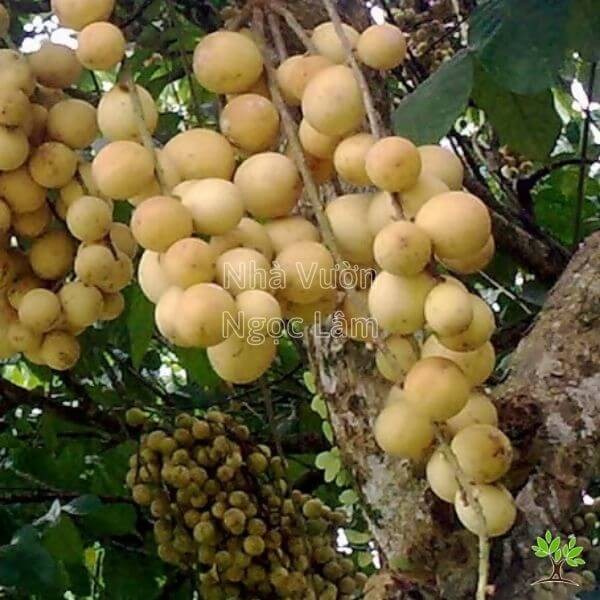 Cluster of ripe Langsat fruit hanging from a branch
Cluster of ripe Langsat fruit hanging from a branch
Characteristics
Originating from Southeast Asia, particularly Malaysia, the Langsat (Lansium domesticum) is a sought-after unique fruit tree belonging to the Mahogany family. The ‘Thai Bon Bon’ variety is particularly popular for its rapid growth, early fruiting, robust health, and resistance to pests and diseases.
This fruit-bearing tree is a specialty of mountainous regions in its native range. Langsat trees are characterized by their straight, woody trunks with yellow or reddish-brown bark, growing vertically to an average height of 15-20 meters.
The leaves are compound, consisting of five to seven leaflets that are long and tapered, measuring about 8 to 13 cm. They are stiff, pinnately arranged, and smooth. Small, fragrant flowers bloom at the branch tips in clusters, featuring five petals in pale yellow or white. Langsat trees are typically dioecious, meaning male and female flowers are on separate plants.
Langsat fruit is round with a thin outer peel that often contains a sticky latex. The fruit is pale yellow when ripe and grows in clusters of 4 to 30 fruits. Inside, the fruit consists of several translucent, juicy segments with a delightful sweet and sour taste, separated by thin walls. Unlike many fruits, Langsat is best peeled from the bottom upwards for ease of consumption.
Nutritional Value & Benefits
A study highlights the fiber content in Langsat: 100g of ‘Thai Bon Bon’ contains about 2g of fiber, contributing 8-11% of the daily fiber needs for women and 6-8% for men. Regular consumption of Langsat fruit helps supplement dietary fiber.
The fiber content offers several health advantages:
- Cardiovascular Health: Adequate fiber intake helps reduce the risk of heart disease.
- Improved Digestion: Fiber supports a healthy digestive system and helps prevent constipation.
Canistel Tree (Eggfruit / “Bánh Kem”)
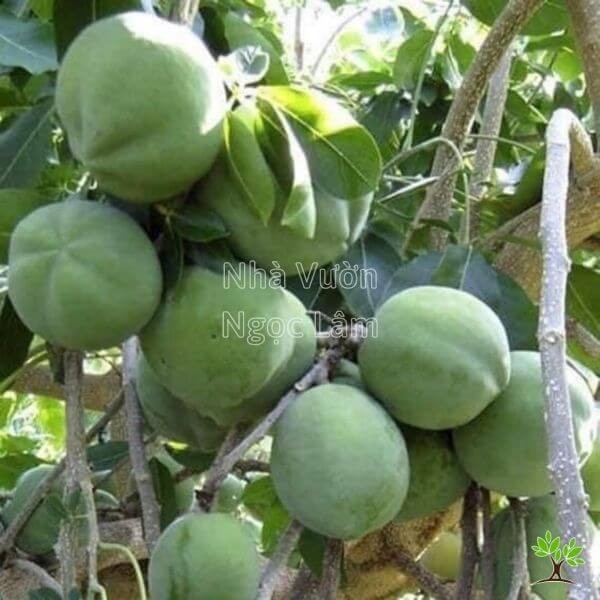 Ripe Canistel fruits on a tree branch
Ripe Canistel fruits on a tree branch
Characteristics
The Canistel (Pouteria campechiana), often nicknamed “Eggfruit” or “Cream Cake Fruit” for its texture and flavor, is another unique fruit tree gaining popularity. Native to Central Mexico, this long-lived woody tree features dark green leaves that are long and divided into five lobes.
The flowers are small, odorless, yellowish-green, and typically have four or five petals, growing from leaf axils. Grafted Canistel trees usually start bearing fruit quickly, sometimes within two years of planting, from an initial height of around 30-40 cm.
Nutritional Value & Benefits
Canistel is highly nutritious and beneficial for health. The fruit has a subtly sweet aroma and a texture often likened to a dense, cooked egg yolk or a rich custard, hence the name “Cream Cake Fruit.” Its flavor is sweet, often described as resembling sweet potato, pumpkin, or caramel, without artificial coloring.
For those seeking weight management, Canistel can be a valuable addition to the diet. The high fiber content helps promote a feeling of fullness, reducing cravings and aiding in weight loss efforts.
Canistel is also excellent for supporting the body during physical training regimes. Furthermore, its high calcium content contributes to healthy bone development in children and helps maintain strong bones and joints in adults and pregnant women.
Brazilian Cherry (Grumichama)
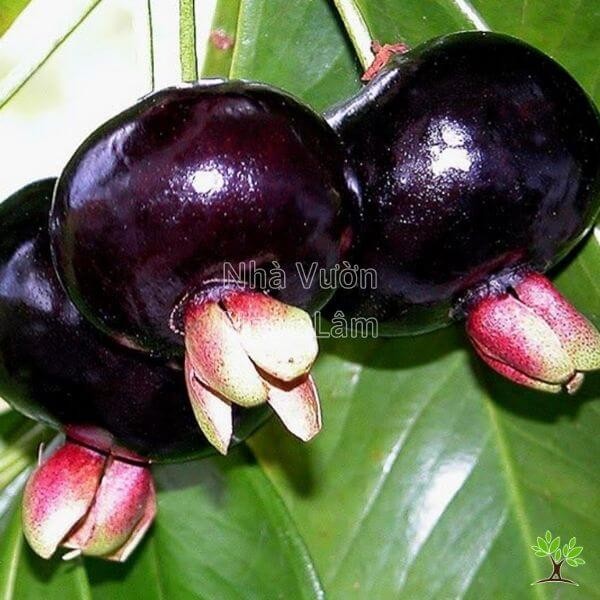
Characteristics
The Brazilian Cherry (Eugenia brasiliensis), also known as Grumichama, is a unique and attractive fruit tree originally from coastal Brazil. Its introduction to other regions, including Vietnam, has created excitement among fruit enthusiasts.
This is a long-lived woody tree with tapered leaves that somewhat resemble plum leaves. When it flowers, the tree produces delicate white to pale pink blossoms. The ripe Brazilian Cherry fruit is round, thin-skinned, and typically measures about 2.5 cm in diameter, turning from red to dark purple when mature. The fruits hang on long stems in clusters. They possess a mild, pleasant aroma and a sweet-tart flavor reminiscent of a cherry or plum, offering a delightful and refreshing taste experience.
Nutritional Value & Benefits
Brazilian Cherries offer significant nutritional value:
- Vitamin C Powerhouse: Research indicates that Brazilian Cherries are incredibly rich in Vitamin C, potentially containing up to 20 times the amount found in blueberries.
- Beta-Carotene for Vision: They contain Beta Carotene, beneficial for eye health and contributing to sharper vision.
- Antioxidant and Immune Support: Beta Carotene also acts as an antioxidant and helps boost the body’s immune function.
- Melatonin for Sleep: The fruit contains Melatonin, a hormone that can help regulate sleep patterns and promote deeper, more restful sleep.
Studies have also suggested that the Anthocyanin content in Brazilian Cherries may help improve the body’s ability to produce insulin, making this fruit potentially beneficial for individuals managing diabetes.
Walnut Tree
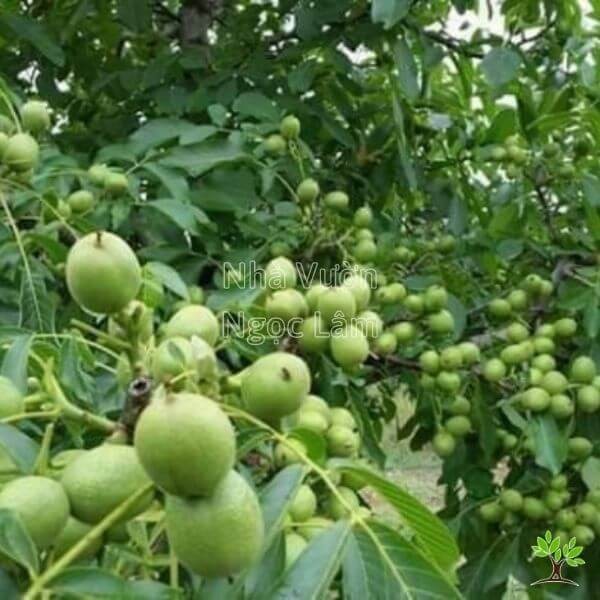 Collection of fresh walnuts in their shells
Collection of fresh walnuts in their shells
Characteristics
When discussing unique and valuable fruit trees, the Walnut tree (Juglans genus) is an essential mention. Walnut trees are large, deciduous trees that can grow from 10 to 40 meters tall. Their leaves are large, pinnately compound, and measure between 20 and 100 mm in length, divided into multiple leaflets.
Walnuts are primarily cultivated for their nuts, which consist of an outer shell and a nutrient-rich kernel inside. There are about 21 species of Walnut trees distributed across continents. Certain species, particularly those native to North America, are also valued for their high-quality timber used in fine furniture.
Nutritional Value & Benefits
The nutritional density of walnuts makes the tree highly sought after. Walnut kernels are packed with beneficial compounds, contributing to numerous health advantages:
- Anti-Inflammatory Properties: Walnuts contain compounds that help the body combat inflammation.
- Improved Digestive Health: Their fiber content supports a healthy gut microbiome and aids in digestion.
- Weight Management Support: Walnuts can be a satisfying snack that helps control appetite and supports weight management efforts.
- Rich in Antioxidants: Abundant antioxidants contribute to youthful skin and protect against cellular damage.
- Cognitive Function: Walnuts are particularly known for supporting brain health, improving memory and overall cognitive function.
- Diabetes Management: Studies suggest walnuts can be beneficial for individuals with Type 2 diabetes.
Finger Grape
 Cluster of ripe Finger Grapes on the vine
Cluster of ripe Finger Grapes on the vine
Characteristics
Finger Grapes, also known by variety names like Sweet Sapphire or Tear Drop grapes, are a unique fruit with a striking appearance that immediately captures attention. Despite their unusual look, their delicious flavor wins over anyone who tries them. These grapes typically grow in clusters and have an elongated, tubular shape, truly resembling small fingers. When ripe, the fruits are dark purple or reddish-purple and have a smooth, taut skin. Eating them provides a crisp texture and a distinctly sweet, satisfying taste with a pleasant aroma. This particular variety is often the result of hybrids between American and Mediterranean grape species.
Nutritional Value & Benefits
Finger Grapes are a favorite among many, particularly parents, due to their appealing shape and nutritional content, making them a great snack for children. They contain numerous vitamins and minerals beneficial for health, especially supporting a healthy digestive system in young ones. To enhance the flavor and nutritional value of dishes, Finger Grapes can be added to fruit salads or other culinary creations.
Yellow Dragon Fruit
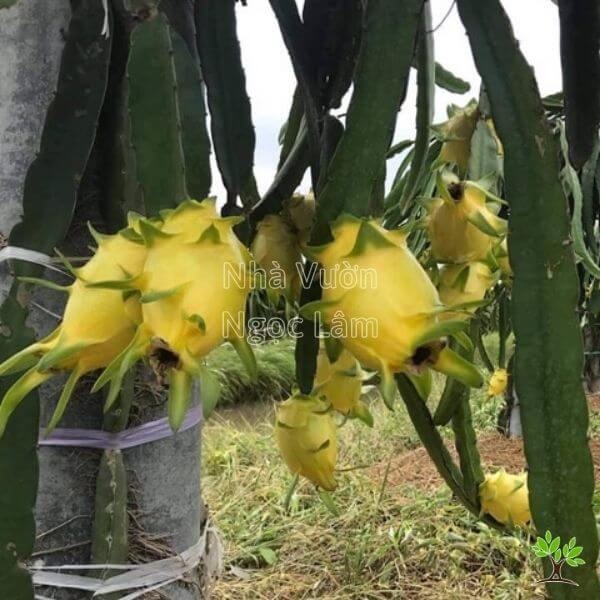 A ripe Yellow Dragon Fruit with thorny skin
A ripe Yellow Dragon Fruit with thorny skin
Characteristics
Beyond the common red or pink-skinned dragon fruit, the Yellow Dragon Fruit (Selenicereus megalanthus) is a highly prized variety, sometimes referred to as “Bird’s Nest Dragon Fruit” due to its perceived superior quality and sweetness.
The true origin of the Yellow Dragon Fruit is Ecuador, a country in South America (not Central America as stated in the original, but the region is correct). This variety is characterized by having more spines than the common red or pink types.
When unripe, the skin is green and covered in noticeable spines, easily distinguishing it from other dragon fruit. As the fruit ripens, these spines detach. A ripe fruit typically weighs around 250 grams. The flavor is notably sweeter and more subtly flavored than other dragon fruits, with a delicate taste often compared to the sweetness of bird’s nest soup, leading to its nickname.
Nutritional Value & Benefits
Yellow Dragon Fruit is rich in vitamins, minerals, and antioxidants beneficial for the body. According to scientific studies, 100 grams of Yellow Dragon Fruit contains approximately 268 calories, with 82% carbohydrates. Its high fiber and water content make it excellent for digestive health, helping to prevent constipation and maintain a healthy gut.
Tamarillo Tree (Tree Tomato)
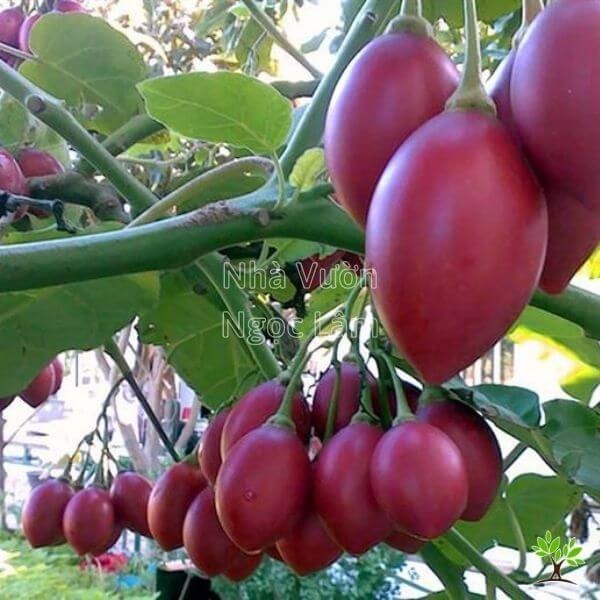 A cluster of ripe red Tamarillo fruits
A cluster of ripe red Tamarillo fruits
Characteristics
The Tamarillo (Solanum betaceum), also known as the Tree Tomato, is another unique fruit tree species. It has gained popularity and commands a relatively high price in many markets, including Vietnam, due to its novelty and distinctive characteristics. Many people are curious to try this fruit because of its unusual appearance compared to common tomatoes.
Originally from the Andes region of South America, the Tamarillo is now cultivated in many countries worldwide. The fruit is typically orange-red, has an elliptical shape, and differs significantly in appearance from standard tomatoes. The tree has a high fruit-setting rate and is relatively resistant to pests and diseases.
Nutritional Value & Benefits
Tamarillos are highly nutritious, containing significant amounts of Vitamin C, Vitamin E, Beta-Carotene, and other antioxidants like Lycopene, making them very beneficial for health. Due to its unique shape and nutritional profile, the Tamarillo is a fruit with high economic value. In some markets, it can fetch prices around 1 million VND per kilogram (equivalent to approximately $40-45 USD/kg at typical exchange rates), highlighting its status as a valuable exotic fruit.
Fuyu Persimmon (Crunchy Persimmon)
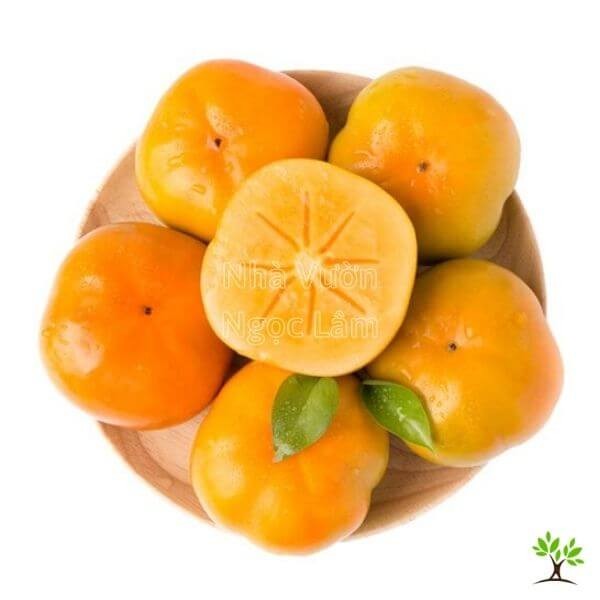 Ripe orange Fuyu Persimmon fruit on a branch
Ripe orange Fuyu Persimmon fruit on a branch
Characteristics
The Fuyu Persimmon (Diospyros kaki ‘Fuyu’), often referred to as “Crunchy Persimmon,” is a fruit tree with significant nutritional and economic value. Widely cultivated, including in regions like North America (though its origin is typically East Asia), it belongs to the Diospyros genus.
The Fuyu Persimmon tree is a small woody tree, typically reaching a height of around 2 meters. Its leaves are oval or tapered and arranged alternately. The fruit has a flattened, slightly square shape, resembling a flattened tomato. When ripe, the Fuyu Persimmon turns vibrant yellow or orange-red, making it very visually appealing. The fruits often grow in pairs. Unlike many other persimmon varieties, Fuyu is non-astringent even when firm, allowing it to be eaten while still crisp, hence the name “Crunchy Persimmon.”
Nutritional Value & Benefits
Fuyu Persimmons are rich in micronutrients that offer substantial health benefits. They contain antioxidants that may help in cancer prevention. Fuyu Persimmons are also highly beneficial for boosting the body’s immune system. They contain Ascorbic Acid (Vitamin C), providing about 80% of the daily recommended intake per fruit. Vitamin C is crucial for stimulating the immune system and promoting the production of white blood cells that fight off bacteria, viruses, and fungi.
Regular consumption of Fuyu Persimmons also supports healthy digestion. Like most fruits, Fuyu Persimmons are an excellent source of dietary fiber. This fiber stimulates peristalsis, the muscular contractions that move food through the digestive tract, promoting regularity. Due to their high fiber content, Fuyu Persimmons are also effective in aiding weight loss and preventing obesity by helping you feel full longer.
Where to Find Unique Fruit Trees?
“Where can I buy unique fruit trees?” is a common question for anyone inspired to grow these fascinating plants. Biogarden.asia is your trusted source, offering a wide selection of unique fruit tree varieties. We are committed to providing healthy, vigorous plant stocks that meet high standards, ensuring good resistance to pests and diseases. Our team is always available to provide dedicated technical consultation and support for your planting needs.
Biogarden.asia also offers competitive pricing to meet the demands of growers. For customers requiring plant delivery over long distances or across provinces, we have established efficient solutions to ensure timely and safe transport. If you wish to explore the unique fruit tree varieties currently available at Biogarden.asia, I invite you to visit our website.
These insights into just some of the many unique fruit tree varieties available today highlight the exciting possibilities for expanding your garden and enjoying diverse, nutritious fruits. We hope this information helps you choose the perfect unique plant species to cultivate.



